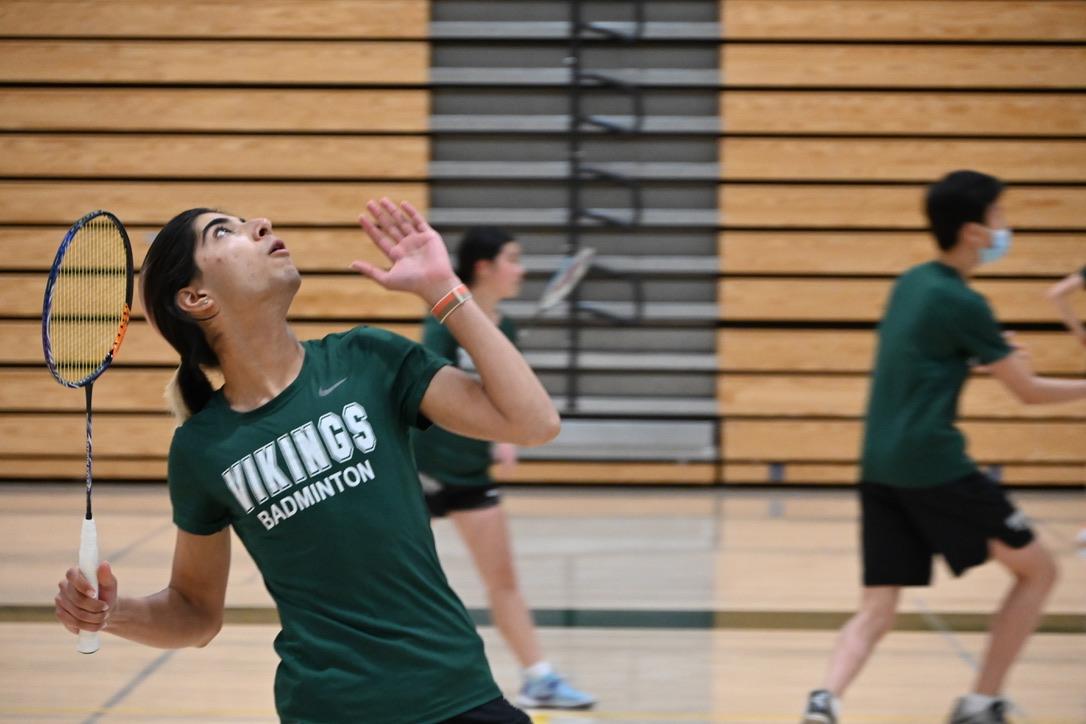“I froze and I didn’t know what to say.”
Earlier this season, an opposing team’s coach told Palo Alto High School junior Hazel Malik before a badminton match that Malik, who identifies as a trans woman, appeared to be playing at the wrong event. Though presenting and identifying as a female, she began the season playing in boys’ events.
“The coach got really confused because he thought I was a girl, but then he saw me playing boys doubles and there was a little bit of commotion about it,” Malik said. “I thought about that day a lot and then I just decided that I wanted to move over because it just felt like the right time.”
Malik said that she decided to switch to the girls’ events following the incident with a match against another high school.
As part of less than one percent of teens in the United States who identify as transgender, Malik’s presence on the girls badminton team places her at the forefront of a culture war surrounding the participation of trans athletes in gendered sports. This is despite the fact that Malik accurately followed procedures set by the Central Coast Section (CCS) commissioner, the person who runs Santa Clara County’s high school athletics organization, that were at times hard to find.
“I’ve had to coordinate a lot of people so they can just talk about my situation because there is minimal real guidance,” Malik said.
She completed the process of switching teams mid-season. To do this, CCS required a witnessed conversation between Malik and an administrator, in this case Assistant Principal Ladonna Butler, about her decision and confirmation of Malik’s status from the school. Malik said she felt more secure after joining the girls team.
“I thought about that day a lot and then I just decided that I wanted to move over because it just felt like the right time.”
— Hazel Malik, junior
“After [switching to the girls team] it was really affirming,” Malik said.
Switching teams
In California, according to Assembly Bill 1266 signed into law in 2014, transgender athletes of any grade level may compete based on their gender identity. However, when Malik checked in with CCS to find a procedure to follow, she found the website did not have the updated information on the criteria to switch teams.
“They probably updated the guidelines without actually updating the website because they have different information in their [online] bylaws than they do in real life,” Malik said.
Despite the lack of a clarity in the system for trans athletes, Malik said that the Paly administration worked with her to find a way forward. After calling a CCS representative to receive the correct steps, Malik was able to switch teams.

“Paly specifically doesn’t really have much on this [protocol for trans athletes] and I can’t really blame them because no one has much on this,” Malik said. “But it’s not like they’re unwilling to do anything about it. The assistant AD [former Paly Athletic Director Fatima Giffen] was up late at night with me trying to figure out how we could actually get this thing done because there was no clear information on it.”
Butler and Giffen, who helped Malik through the process, both declined Verde’s requests for an interview.
When Malik joined the girls badminton team mid-season, its roster had to be shifted because not all players on the team can compete at the varsity level, according to junior and varsity girls doubles player Sandhya Krishnan.
“The move caused a number of changes late into the season, one of which was SCVALs [Santa Clara Valley Athletic League],” Krishnan said. “Although her skills were more fit to attend, if she had not moved I would have still had a chance to play SCVALs.”
A growing national debate
While California allows high school students to compete based on gender identity in all cases, that is not the case everywhere in the United States. As of 2021, 10 states have passed bills which prevent trans athletes from competing in the gender with which they identify and 28 more have proposed legislation to place limits on trans athletes.
A number of these laws completely ban transgender athletes from K-12 sports as well as college and professional sports. According to an opinion by Duke’s law school professor Dorianne Coleman, National Collegiate Athletic Association Division I transgender athlete Juniper Eastwood and former tennis player Martina Navratilova, failing to consider the difference between high school sports and professional or higher-stakes college sports is a mistake considering the social and health benefits of sports for young people.
“The reality is, as a trans woman, if you managed to win anything of significance in sports, then you’re going to get some fairly serious backlash.”
— Joanna Harper, researcher and trans athlete
Joanna Harper, a former trans athlete and co-author of the International Olympic Committee’s 2015 guidelines on trans athletes, agreed that high school should be considered differently than college and professional sports.
“Most of the time, I think we can allow high school athletes to compete based on gender identity,” Harper said. “But for high-performing high school trans girls, I don’t believe that’s good enough. I think that there should be some requirements in the upper levels of high school for trans girls to be on hormone therapy.”
Hormone therapy can be a highly effective way of reducing possible advantages that trans women would have in competition.
“Trans women will go from male levels of hemoglobin to female levels of hemoglobin within three to four months of hormone therapy,” Harper said. “While there are many things that are important in endurance sports, the single most important factor is hemoglobin.”
The question of fairness when it comes to trans women in sports is not an easy one to answer.
“Every single activity that involves physical endurance or something physical, they [trans women] will have an advantage,” Malik said. “It’s just a matter of how much and what kind of impact that has. For some sports, it’s negligible compared to the benefits that transgender athletes receive and for other sports it is quite literally a deal breaker.”
As for the protocols that transgender athletes must follow in order to officially change teams, Malik said she feels CCS can protect trans athletes from accusations of having an unfair advantage.
“Restrictions are really good because it gives us protection because we followed the due processes,” Malik said. “It is kind of putting the pressure on whatever organization let us play for us to be there. If there was no restrictions, then there could be a lot of uproar and arguments that come back at us.”
However, Harper was quick to point out that transgender athletes are always going to face a higher level of scrutiny.
“The reality is, as a trans woman, if you managed to win anything of significance in sports, then you’re going to get some fairly serious backlash,” Harper said. “That’s regardless of whatever you have done [to follow the rules].”
“Paly specifically doesn’t really have much on this [protocol for trans athletes] and I can’t really blame them because no one has much on this.”
— Hazel Malik, junior
The backlash that some trans female athletes have faced — for example, swimmer Lia Thomas — showcases how quickly a situation can turn sour for trans athletes. In addition to the 10 mentioned above, nine states introduced bills which would place restrictions on transgender youth in only the first week of 2022. There is concern that the move to legislation could lead to more bills down the line concerning LGBTQ+ individuals.
“I think it’s extremely unfortunate that these politicians are using trans athletes as a quote-unquote wedge issue to limit the rights of all LGBTQI+ Americans,” Harper said.
Despite the fact that the participation of trans athletes is often challenged in the political sphere, Harper said not everyone who opposes trans athletes participating in sports based on gender identity has an underlying agenda.
“I think that it’s also important to be respectful to people with different opinions,” Harper said. “There are certainly some people who have doubts and questions about the wisdom of allowing trans girls, and women in particular, into women’s sports and these people aren’t necessarily anti-trans, anti-queer people.”
Ultimately, Malik understands the gravity of the debate and the place she holds in it, but said she hopes people consider the nuance of the situation.
“There’s politics making it hard for transgender athletes to transition,” Malik said. “It’s more about how much of an advantage [after transitioning] does she have at this point? And how much does that matter?”
A conversation with Joanna Harper
Joanna Harper, a trans athlete and adviser to the Olympic Committee for their 2015 guidelines for transgender athletes, is a pioneer in the field of research on transgender participation in sports.
“One university just can’t do very much because there’s only so many trans athletes you can get, but once we get 20 or 30 universities around the world doing these studies then we can get somewhere,” Harper said. “I think more research, more universities doing this, more funding, all these things are very important.”
Her research will offer insights into how much of an advantage trans women have in different sports, if any.
“While trans women do not lose enough strength to become equal with cisgender women, there was a study done by Air Force personnel where at the start of the study, trans women had a 31% advantage in the number of push ups per minute they could do,” Harper said. “After two years of hormone therapy, the advantage in the number of push ups per minute had completely disappeared. That was true, despite the fact that trans women would still be stronger.”

